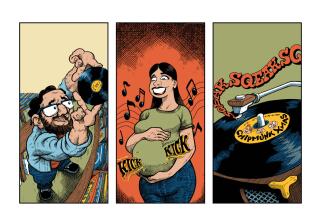Vinyl Album on Last Spin as CDs, Cassettes Move Ahead
- Share via
By the time a fancy turntable called the Finial LT-1 was introduced at the Consumer Electronics Show this month after eight years and $10 million in research and development, the vast consumer market for which it was originally intended had all but disappeared.
The Finial LT-1, which offers a significant technical advance because it uses laser beams instead of a diamond stylus to track the grooves on a vinyl record, was done in by machines whose technology it attempted to mimic: compact-disc players.
“It was certainly the vision of the (inventors) that the economies of scale would enable this product to eventually reach a broader audience,” said Jacques Robinson, president of Carillon Technology Inc., a Sunnyvale-based firm that makes the LT-1. But because album sales fell by two-thirds in the eight years that it took to bring the turntable to market, Robinson says the LT-1, with a list price of $32,000, “now has a more limited future.”
The failure of the Finial LT-1 to reach a mass audience is the latest evidence that the longtime champion of the record business, the vinyl album, is on its final leg--about to go the way of the 10-cent local phone call.
Since the introduction of CDs in 1983, nationwide sales of vinyl albums have declined to $532 million in 1988 from $1.5 billion in 1983, according to the Recording Industry Assn. of America, a Washington-based industry trade group. Compact discs and cassette tapes now account for more than 90% of the record industry’s $6.2 billion in prerecorded music sales, according to a study released this month by Street Pulse Group, a New Milford, Conn.-based market research firm.
Vinyl’s disappearance raises the issue of how the speed of technological innovation can overtake the industry’s ability to devise compensation agreements for its creative segment--the performers, writers and producers of music. Artists worry that when a new format eclipses an existing one, they could be left with a dwindling source of revenue from the old technology and no way to profit from the new.
Their concern recalls the earlier efforts by Hollywood directors, writers and craft unions to negotiate contracts granting them a share of the burgeoning home videotape market in addition to what they received from their work on the silver screen.
In negotiations under way this week in New York, the American Federation of Musicians is seeking to increase the compensation that an estimated 4,000 musicians receive from a Special Payments Fund financed by a royalty levied on the sale of each record, CD and prerecorded cassette tape.
The fund has been shrinking over the last few years because the royalty fee was lowered several years ago and also because sales of LPs, which have the highest royalty rate, have slumped. The current royalty rate is 0.45% of the list price of a CD or tape and 0.52% of the list price of an LP, according to Edward Peters, manager of the federation’s Special Payments Fund.
The union wants royalty rates raised across the board. It also wants musicians to receive an additional premium for each format they appear in, said record industry negotiator Norman Samnick of the New York law firm Strook & Strook & Lavan. Union negotiators would not comment on their proposals.
“A lot of money is at stake here,” said J. Martin Emerson, who is president of the Federation. “There’s no doubt that (musicians’) income from the sale of records has sunk in the last 10 years. We want to address that.”
Peters, who is an employee of the U.S. Department of Labor--which administers the union fund--and not a party to the negotiations, said the Special Payments Fund for musicians averaged $16 million to $24 million after expenses during the 1970s. But it currently hovers around $9 million.
Unit sales of most formats of recorded music are down from their 1978 peaks, but vinyl has been especially hard hit.
Last week, officials of Chrysalis Records confirmed that they have ceased releasing most records on 12-inch vinyl. Although many major record companies have phased out vinyl country and classical records, Chrysalis is believed to be the first major label to publicly acknowledge that it no longer issues vinyl pop music albums.
“Our last two releases have not been on vinyl,” company spokesman Elaine Summers said. “The demand has gotten so small for albums, (we) save money by not pressing them.”
The disclosure by Chrysalis, which records major pop artists such as Billy Idol and Pat Benatar, came only a year after most Music Plus stores in Southern California stopped carrying vinyl albums to devote more space to tapes and compact discs. After the move by Music Plus, other major record stores have also followed suit.
“Vinyl is fading fast,” said Russ Soloman, president of the 54-store Tower Records chain in Sacramento. “Companies are not issuing things on vinyl because the active record buyer has converted to CDs.”
Still, the dramatic decline in album sales has occured despite surprisingly widespread ownership of vinyl albums and turntables.
Phansteihl, one of the largest manufacturers of replacement needles, reports that 4.5 million turntables were sold in 1988, the latest year for which the company has figures. In addition, Phansteihl estimates that about 60 million turntables are in use.
By comparison, 5 million compact-disc players were sold in 1988, according to the Electronics Industries Assn. in Washington.
But the maker of the Finial LT-1 says it is not going to use its latest technical advancement to try to revive the mass consumer market for turntables. Instead Carillion Technology is trying to earn back its investment in the Finial LT-1 by marketing the 40-pound machine to broadcasters and extremely wealthy audiophiles who want to preserve their record collections from the scratches and wear and tear of stylus needles.
“I don’t see any way they (LPs) are going to make a comeback,” said Robinson.
More to Read
The biggest entertainment stories
Get our big stories about Hollywood, film, television, music, arts, culture and more right in your inbox as soon as they publish.
You may occasionally receive promotional content from the Los Angeles Times.










